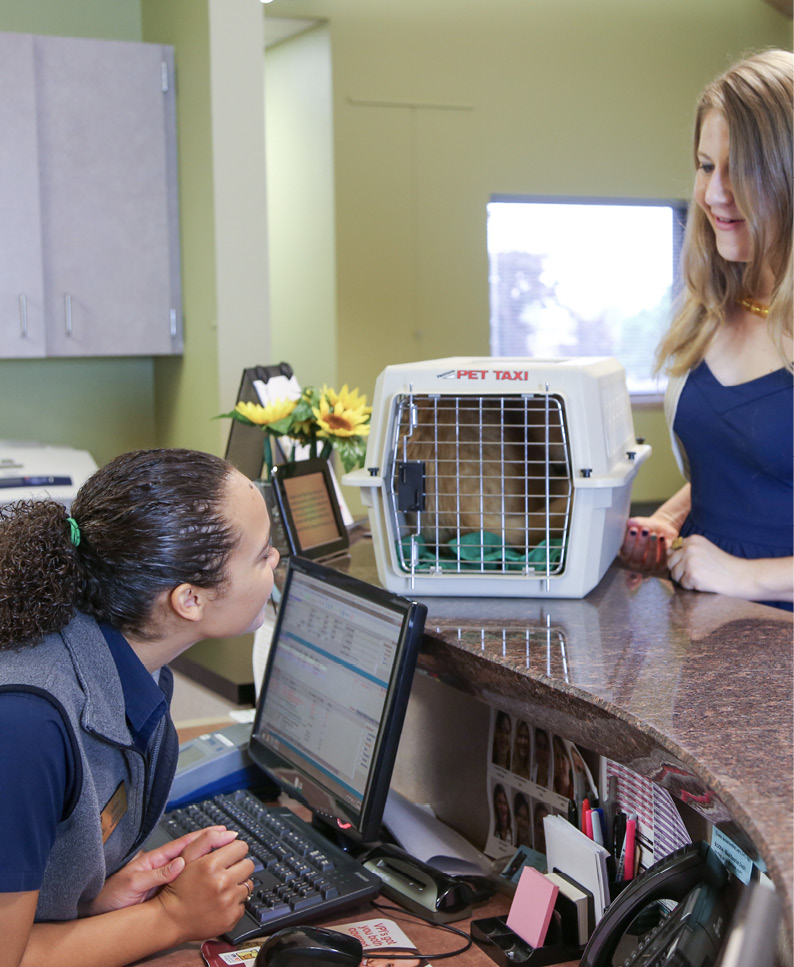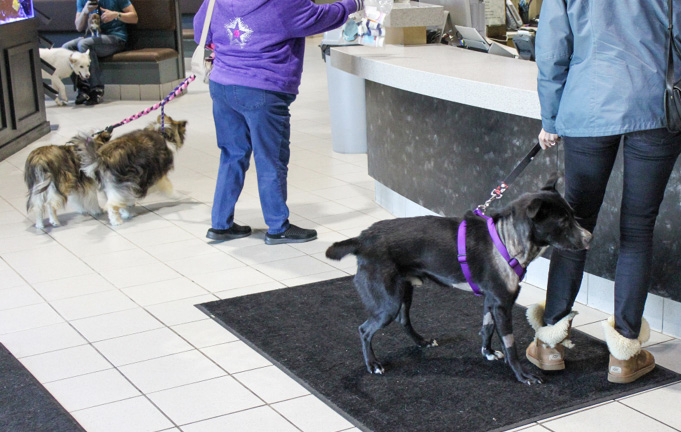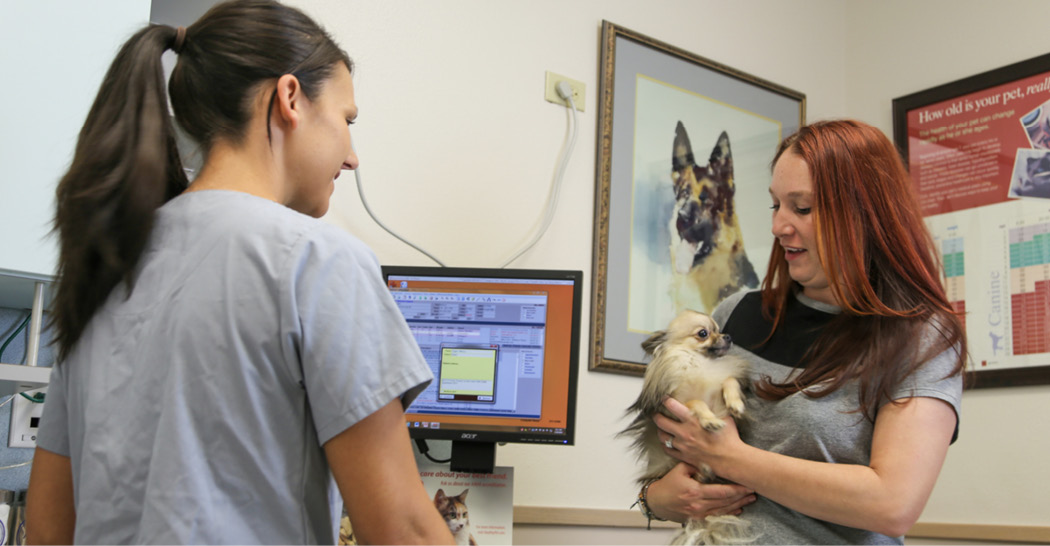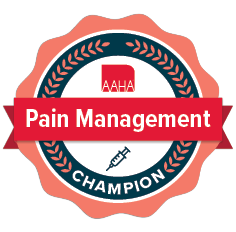Pain Management Is a Team Sport
Everyone in the Practice Can Play a Role
by Kate Boatright, VMD

CSRs play a key role in starting the conversation about patient pain, and their role in pain management can start even before a patient enters the hospital.
“Do you think my pet is in pain?” is a common question from concerned pet owners. A pain-free life is a priority for pet families, yet many do not recognize the subtle signs of pain their pets display. The prevention and management of pain in veterinary patients is a core responsibility that should be shared by all members of the veterinary team.
“Recognizing and treating pain is vital for patient care, quality of life, and our obligation as veterinary professionals,” said Alison Gottlieb, CVT, VTS (ECC) Elite FFCP, LSHC-S, of Hickory Veterinary and Specialty Hospital.
Creating a Team that Prioritizes Pain Management
The development of a written pain management plan is a great starting place for veterinary clinics. This plan “needs to include everyone using a consistent species-specific pain scale, implementing a pet-owner pain assessment scale, and written protocols for multimodal pain treatment for acute, chronic, and surgical conditions,” says Jennifer F. Johnson, VMD, CVPP. It is important to recognize that there are different types of pain that require different assessments, interventions, and client education. The 2022 AAHA Pain Management Guidelines for Dogs and Cats provide a resource for veterinary teams who are looking to maximize their pain management strategies.
All team members should understand the importance of pain management and receive training on how to recognize pain in patients and talk about pain with pet owners. Regardless of their position, every individual should feel comfortable discussing concerns for patient pain with the attending veterinarian to ensure that nothing gets missed. “The entire [veterinary] team needs to be on board for analgesia to get to our patients,” said Gottlieb. “The most important part is ensuring everyone agrees relieving pain is the focal point of patient care.”
Client Service Representatives: Eyes and Ears in the Waiting Room
Client service representatives (CSRs) play a key role in starting the conversation about patient pain, and their role in pain management can start even before a patient enters the hospital. As the team members who are fielding phone calls and other communications, they should be aware of both obvious and subtle signs of pain that owners might describe when they call with a question or to make an appointment. If a CSR recognizes a client’s concern as a possible sign of pain, they should encourage the owner to schedule an appointment for a full evaluation and discussion with the doctor. If clients are calling in with postoperative concerns, the CSR should listen for reports of signs that might be due to pain, determine if the owner is giving postoperative medications as prescribed, and pass the concern off to a credentialed veterinary technician or veterinarian for follow-up.

“I often learn a great deal about canine pain while spending time in the waiting room.”
—Alison Gottlieb, CVT, VTS (ECC) Elite FFCP, LSHC-S
For clients who are coming to an appointment for pain assessment or mobility concerns, CSRs can suggest that the client record videos of their pet during their daily life so that the veterinarian can see the animal’s behavior in their home environment. This can be an especially powerful tool for pain evaluation in cats, as they often will not walk around the examination room during an appointment. CSRs can also send pain assessments to owners prior to the appointment or provide them upon arrival at the clinic. These tools should be utilized for any patient presenting with a pain or mobility concern and for patients at higher risk of osteoarthritis, such as senior pets or pets with known orthopedic disease.
Finally, CSRs are often the first team members to see a patient arriving at the clinic. Gottlieb noted, “I often learn a great deal about canine pain while spending time in the waiting room.” How patients move in and out of the building and move from a sitting or lying position to standing can demonstrate evidence of pain. “Ensuring CSRs have the knowledge to pick up on these signs greatly improves the team dynamic,” said Gottlieb. They should make other members of the veterinary team aware of their observations, as patient behavior may change in the examination room or treatment area.
Veterinary Assistants: Managing Pain in the Exam Room

When taking a history, assistants should ask specific questions about mobility and potential subtle signs of pain, such as changes in appetite, sleeping habits, litterbox use, aggression, and other behaviors.
Veterinary assistants should feel comfortable recognizing signs of pain in patients as well, both while observing or handling them and obtaining a history. Observing how a patient moves when bringing them from the waiting area into an examination room offers an initial evaluation. Assistants should be empowered to be proactive about patient comfort in the exam room. For instance, if they note that a dog is having trouble getting up or slipping on the floor, they can provide a rug or other surface with more traction to help ensure patient comfort and prevent exacerbation of pain.
When taking a history, assistants should ask specific questions about mobility and potential subtle signs of pain, such as changes in appetite, sleeping habits, litterbox use, aggression, and other behaviors. They should feel comfortable sharing their observations of the patient and any “red flags” in the history with the attending veterinarian.
Finally, the way veterinary assistants handle patients can also help to both detect and manage pain. “Knowing proper handling for patients with chronic pain will provide a much better patient experience,” said Gottlieb. Assistants should be trained in various handling techniques so that they are comfortable restraining and handling patients in a way that is as pain-free as possible.
“Recognizing pain while handling patients…and bringing it to the technicians’ or doctor’s attention is the slam dunk for the team,” continued Gottlieb. Assistants should be keenly aware of a patient’s reaction to being handled in a certain way, placed in a particular position, or palpated on a specific part of their body.
Credentialed Veterinary Technicians: Pain Sentinels for Patients
Roles and Responsibilities of Each Team Member |
|
CSRs
Veterinary Assistants
CrVTs
Veterinarians
Management Team
|
|
Both the veterinarian and veterinary technician oaths include language around the relief of animal suffering, of which pain is a key contributing factor. Johnson advocates for “constant communication between CrVTs and veterinarians. Vets need to trust the nursing staff to evaluate pain and plan treatments accordingly.”
Credentialed veterinary technicians (CrVTs) are highly educated professionals who often “have more patient and owner contact [than veterinarians], which is essential for recognizing and educating on pain,” said Gottlieb. They are the ones observing and monitoring surgical patients, attending to basic needs during hospitalization, and administering most treatments. A validated pain assessment tool should be used by all CrVTs and veterinarians caring for patients to ensure continuity of care and rapid detection of a change in pain status.
“Hospitals need to train CrVTs and allow them the autonomy to make treatment decisions based on changes found with patient comfort,” said Johnson. A treatment plan developed by a veterinarian could include PRN orders for pain medication if the comfort status of a patient changes, especially if a veterinarian is not always immediately available to approve a medication. “I need to be able to communicate and collaborate with the doctor on a pain plan to meet [the patient’s] needs and follow-up if additional analgesia or anxiolytics are needed,” said Gottlieb.
Another powerful tool in pain management is the ability to anticipate pain and pre-emptively manage it. CrVTs should feel comfortable having a conversation with their doctors about the potential for pain and asking if pain medications should be prescribed. This can be especially important for preoperative patients and outpatients with conditions that are not always thought of as painful, such as neoplasia or dermatitis.
CrVTs should also be utilized heavily in client education about pain management strategies. They often have more time than the veterinarian to discuss specific ways to handle a painful pet at home, review medication instructions, and discuss monitoring for changes in patient status that may indicate uncontrolled pain. Scheduling surgical or hospitalization discharges with a CrVT can help to assure owners of patients at risk for acute pain are well prepared. The same CrVT could be tasked with making a follow-up call in a day or two to see how the patient is doing and ask questions of the client to assess the pet at home.
Clients: Pain Evaluation Starts at Home
The final member of the pain management team is the client. These individuals are in the best position to monitor response to treatment and detect changes in the patient that may indicate new or worsening pain. It is the duty of the veterinarian and their team to provide clients with the education and tools they need to carry out this critical role. “The more pet owner education that team members can provide, the better,” said Johnson.
Acute pain is more readily recognized by pet owners in the home environment and may prompt them to schedule a veterinary visit. Chronic pain is often more difficult to detect, as pets do not display the same signs as for acute pain, such as a nonweight bearing lameness or vocalization. “Often, pet owners do not recognize that their pet is in pain because they are wagging their tail or still running around the yard,” said Johnson. Pet owners often miss subtle behavior changes that are indicative of pain—such as the fact that their cat no longer sleeps in their preferred spot on the windowsill, or their dog goes more slowly up and down the stairs. Often, these behavior changes are attributed to “normal” aging.
 “Pet-owner pain assessments are critical to use,” said Johnson. Both Gottlieb and Johnson recommend the use of the Feline Grimace Scale app for monitoring pain in cats. “Cat owners are often surprised to see the facial expressions and how they are key to recognition of pain,” said Johnson.
“Pet-owner pain assessments are critical to use,” said Johnson. Both Gottlieb and Johnson recommend the use of the Feline Grimace Scale app for monitoring pain in cats. “Cat owners are often surprised to see the facial expressions and how they are key to recognition of pain,” said Johnson.
Once pain is recognized by pet owners, veterinarians can discuss the various options for multimodal pain management that are available. Johnson notes that it is important to make pet owners aware that pain management means more than just prescribing narcotics. The best pain management integrates both pharmaceutical and nonpharmaceutical interventions to maximize patient comfort.
Collaboration Improves Patient Outcomes
It is essential that the team advocate for patient comfort throughout outpatient visits and inpatient stays. It is important to remember that pain exists in many forms and is not isolated to the postoperative period, trauma patients, or those with osteoarthritis. Patients with pancreatitis, severe dental disease, corneal ulcers, and many preoperative patients are experiencing pain in the hospital as well. Team members should be trained to be alert for signs of pain in all patients and perform a pain evaluation, regardless of the patient’s reason for entering the hospital.
|
Create a brighter tomorrow for companion animals and build a future where pain has no place in the lives of our patients. Stay a step (or several) ahead of pain. The AAHA Pain Management Guidelines Certificate provides a comprehensive dive into effective multimodal approaches focusing on preemptive and proactive treatments with excellent team coordination. Visit aaha.org/certificates for more information. |
“[Keep] pain in mind with every diagnostic test and potential treatment,” recommended Gottlieb. Even a diagnostic procedure as routine as venipuncture could become painful for a patient depending on how they are restrained and handled. CSRs and assistants should alert CrVTs and veterinarians to signs of pain in a patient and ensure that the patient is handled in a way that minimizes pain. It is also important to remember that there are many pain management tools that are nonpharmaceutical, such as warm compresses, padded bedding, and cold laser therapy, that can be employed for patients during their stay.
“Everyone needs to be on the ‘same page’ where the culture of the practice places an emphasis on pain management for superior outcomes,” said Johnson. “Every small animal general practice can benefit from making pain management a priority. Your patients will heal faster after surgery, you will recognize fewer complications, and you will create better long-term outcomes for patients with chronic pain.”
 |
Kate Boatright, VMD, is a small animal veterinarian, speaker, and author in western Pennsylvania. She graduated from the University of Pennsylvania in 2013 and has worked in rural small animal general practice and emergency clinics ever since. She is passionate about inciting positive change in the profession through mentorship, advocating for spectrum of care, and servant leadership in organized veterinary medicine. |
Photo credits: ©AAHA/Kimberly Lamb, ©AAHA/Kate Moore, Delmaine Donson/iStock via Getty Images Plus




